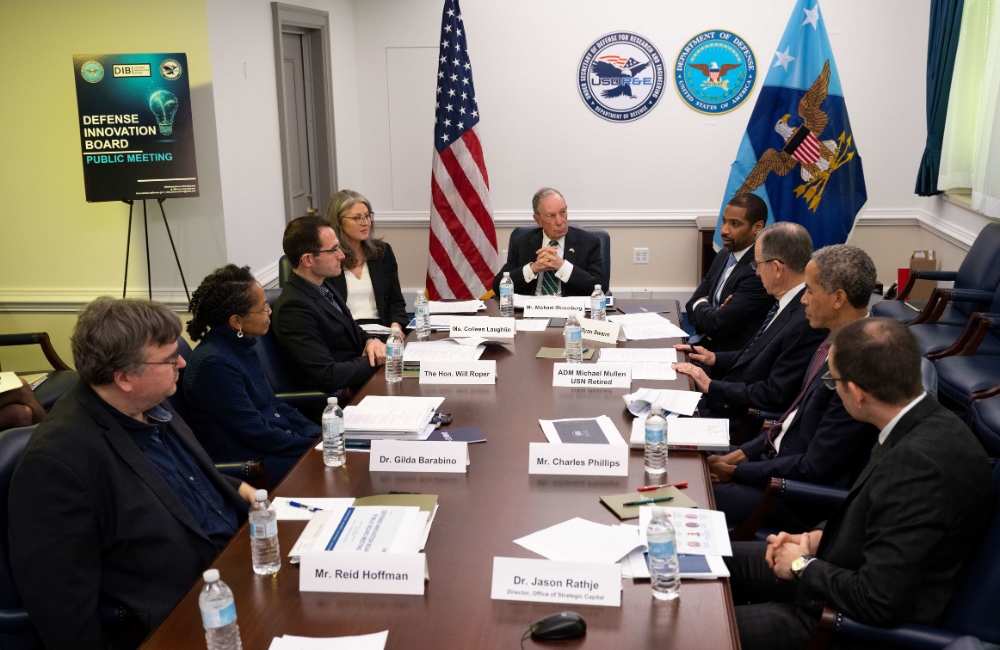Talent, Resource Shortages Hinder Defense Innovation
Defense Innovation Board members received an update from the science and technology and strategic investment capital task forces.

Culture and resource shortages are primary challenges to advancing innovative technologies for the defense community, according to members of the Defense Innovation Board during an open meeting Wednesday.
During the meeting, the second one held since its reformation under new Chairman Michael Bloomberg, the board received an update on the National Defense Science and Technology strategy and heard from the new Office of Strategic Capital and the U.S. Air Force.
Mandated by Congress and informed by the 2022 National Defense Strategy (NDS), the new science and technology strategy will provide a framework for the U.S. military to build a competitive advantage and strengthen its technological superiority.
The board’s science and technology task force said it received an initial briefing from the strategy writing team on how the Defense Department views the development, implementation and longer-term impact in this space. It also met with the services, joint staff and Indo-Pacific Command (INDOPACOM) to understand how the science and technology strategy will structure their priorities, incentives and outcomes.
“The big takeaways are the importance of resources, talent, transition and how to optimize the system for speed and delivery of capabilities,” board member Ryan Swann, chief data analytics officer at Vanguard, said during the meeting. “We ultimately want to understand how the S&T enterprise is set up to efficiently and effectively deliver these capabilities to the warfighter.”
Member Gilda Barabino, president at Franklin W. Olin College of Engineering, said she wanted to see the strategy address the broader innovation ecosystem, including academia and the private sector, and outline how DOD can deepen and leverage that. She said the strategy needs to address the culture and how to create larger pipelines of talent into the national security sector.
“The strategies are good, but implementation and metrics is how strategy delivers,” Adm. Michael Mullen, former chairman of the Joint Chiefs of Staff and DIB member, said during the meeting. “We have to change the culture. It’s a tough culture. This affects everything from speed to risk tolerance, which are key. The bottom line is strategy is important, but the system has to deliver game-changing advantages for our warfighter that speed and proof will be in the implementation.”
The board’s strategic investment capital task force is conducting a study to better understand the challenges private companies face when working with DOD. The board will deliver their recommendations to the secretary of defense by June.
The task force on strategic investment capital launch follows the Office of Strategic Capital’s founding to address the so-called “valley of death” that has plagued DOD’s ability to bring in new technology and speed up innovation for a long time.
“We really need to talk to people outside the department. And it’s not just startups. … We really need to speak with investors. We also need to speak with defense companies that have been working with us for decades about how they view working with companies that have a different track record than just being part of the defense industrial base only,” board member William Roper, former assistant secretary of the Air Force, said during the meeting. “What is the department doing to encourage or make it easier to work with such companies?”
The purpose of the meeting and the board’ mission is to provide defense leadership with “independent advice and strategic insights” on emerging technologies and their impact on national security. The closed portion of the meeting discussed topics such as the science and technology threat landscape, strategic implications of DOD’s innovation ecosystem, and opportunities and challenges when engaging the commercial sector and non-traditional companies.
This is a carousel with manually rotating slides. Use Next and Previous buttons to navigate or jump to a slide with the slide dots
-

How TMF is Helping Agencies Accelerate Tech Modernization
The program launched a new AI pilot to expedite TMF applications as agency leaders urge more to consider applying for funds.
4m read -

Defense Board to Pitch Solutions for Closing Tech Talent Gaps
Defense Innovation Board members cite need to modernize people management the same way government modernizes technology.
4m read -

How Agencies are Upskilling the Workforce in AI
Federal officials are putting in place new training and education methods to ensure its overall workforce understands the technology.
3m read -

A Prepared Workforce is Key to Cyber Resiliency
Strong training strategies and emphasizing cyber hygiene basics enhance security practices at federal agencies.
2m read




